Snow may look pretty on your roof but is only safe to a certain thickness and weight. If you live in a snow-prone region, you know the destructive effects it comes with; it can lead to roof leakages that may eventually collapse your entire house.
There are various methods to remove snow from your roof; you can use a rope, wire, an avalanche system, rake, shovel, DIY tools or simply melt the ice with a steamer. The method will depend on how much snow there is on the roof, and what type of snow it is. Following are the steps to get rid of the rice from the top of your house, plus tips, precautions and prevention measures.
In our experience, only attempt to remove snow from the roof of a house without a story building or one with a single story. There’s a major risk with higher floors as falls and injuries are common with roof activities. in such a case, simply call for an expert to do the job.
Remove Snow from Roof with Rope
The use of a rope to remove snow off your roof is among the easiest and cheapest as the tools are always available in the home. Chances are high that you have a rope in the house which can be put to this use.
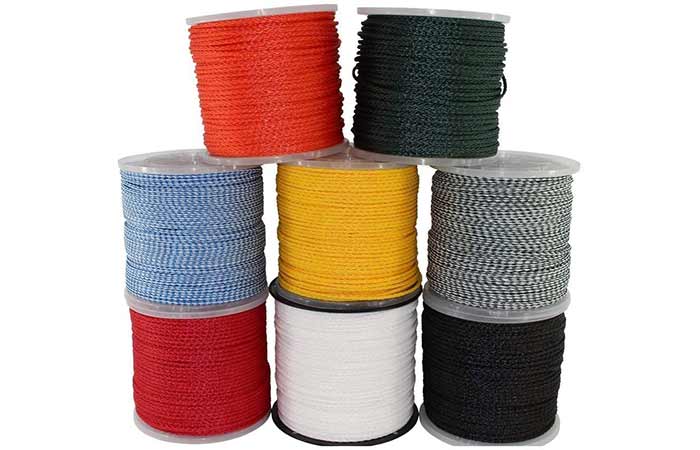
You can remove snow off the roof with this method in the following steps:
- If it is a pile that is not too wide, simply throw the midsection of a rope over a pile of snow on the roof while keeping hold of the ends of the rope.
- If it is a wide pile on taller roof, tie one end of the rope with some weight, use a ladder to get on the roof, while holding onto the end without weight toss the weighted end to the ground, wrap the rope around the edge of the piled snow then climb down.
- Move back while holding unto both ends of the rope to pull off that pile of snow from the roof. Some can also pull from the other side if the pile is wide.
- Repeat until you’re sure the isn’t any excess snow on the roof.
Depending on the length of the rope you will use, this method gives you a chance to move away from danger as the snow falls. Even better is the fact that this method doesn’t require much skill and can thus be undertaken by anyone especially if your roof is reachable from the ground
The disadvantage is that you cannot use it on an extremely tall roof. It may be risky especially if you have to climb on the roof. It is also not the best for flat roofs.
Caution: We have suggested climbing on the roof to anchor the rope properly, remember it is a risky and time-consuming endeavor which shouldn’t be attempted if you lack proper experience.
How to Remove Snow from Roof with Wire
This method basically involves taking a piece of wire wrap it on base and pull it off. Works best if you have a pitched or a lean-to roof type. You may hear other people calling this method wire cutting snow.
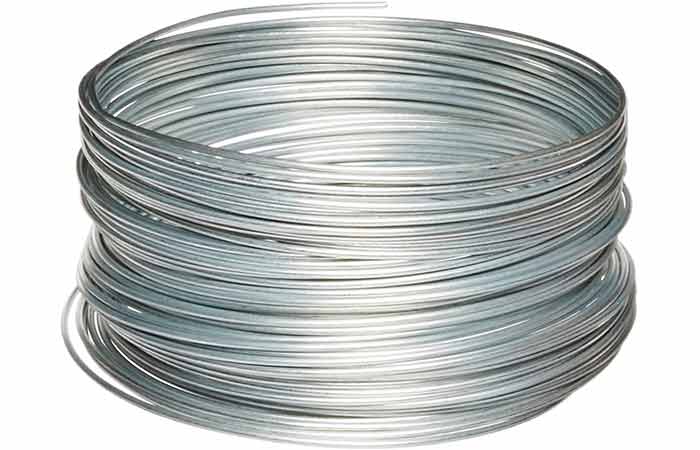
Using a wire to remove snow off your roof is actually very similar to using a rope for the same task. Owing to the stiffness of a wire compared to a rope, you’re in better position to remove the snow off the roof with a wire as it affords you more control of the process.
The steps are as follows:
- Find a long piece of wire enough to cover a significant part of the roof at once.
- Throw the midsection of the wire directly over a pile of snow on the roof of your house while still holding both ends of the wire.
- Move backwards while pulling on both ends of the wire to pull the snow off the roof. Repeat until you’re sure the snow on the roof is light.
For better results, you can have a person holding each end of the wire to pull off a larger size of the snow.
Pros and cons of using a wire
Pros
- Easy and quick
- Affordable
- Stiff/stronger thus better than a rope
Cons of using a wire
- It is unsafe because cutting a huge heap of snow with a wire can hit you causing severe injuries.
- It is straining and needs energetic people to remove snow.
- It is risky to climb tall roofs with snow to install the wire.
Raking Method
Raking snow off the roof is among the most favored methods given its effectiveness and safety levels. It’s a simple procedure in which you use an aluminum pool about 20 feet long to pull ice off the roof.
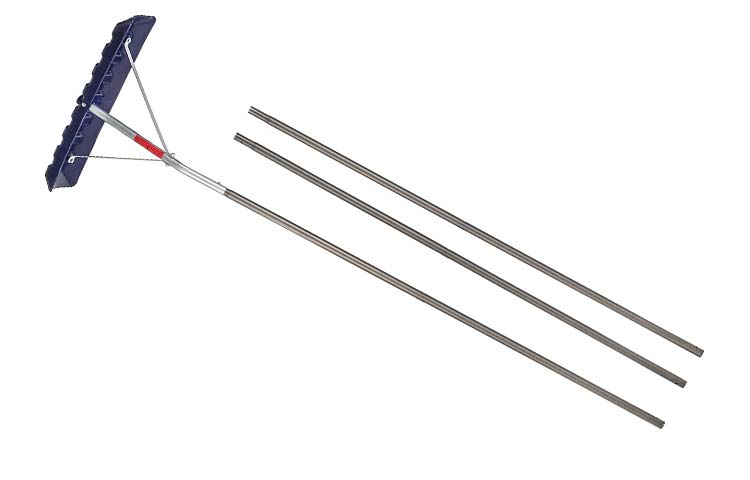
Recommended Reading: 10 Best Roof Rakes for Snow Removal
Before you use a rake to remove the snow off the roof, be sure that the roof is strong enough to use a rake and there are no parts that can be easily damaged by the process. Also, try to make the process as gentle as possible. One of the best roof rake to get this job done is the Ohuhu Adjustable Telescoping Snow Roof Rake
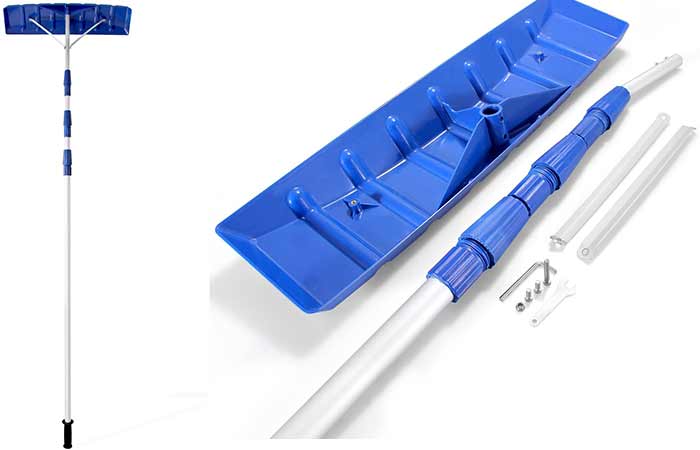
The procedure is as follows:
- If you’re removing the snow from a roof you can’t reach directly from the ground, prop a ladder against the roof then fasten it in place to avoid moving and injuring you.
- If you’re able to rake it off while standing on the ground, stand a few feet from the roof to avoid injury from the falling snow or even better wear a protective head gear
- Slowly pull the snow starting with the area closest to you as you move to the areas further away from you.
Always cut off smaller chunks than the rake can actually take to avoid injury to people and damage to the items below the roof.
The only limitation to the roof raking method is that it doesn’t work on hardened snow and is thus best for the fluffy type
Using a Shovel Method
Shoveling is the riskiest of the snow removal procedures from your roof. The reason for this is that it requires you to climb to the roof to remove the snow.
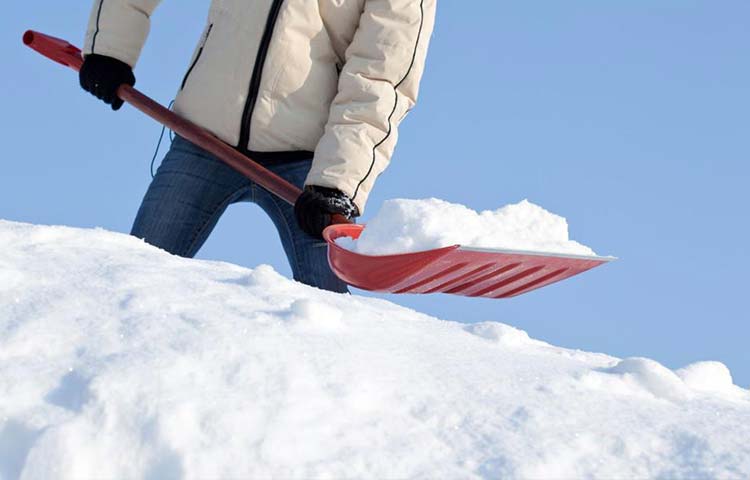
There’s risk in climbing the ladder, the shoveling itself, and the risk of damaging the roof if you step in a weak spot or hit the shovel on a delicate part of the roof.
However, it is the best especially on a flat surface/roof
If you don’t have experience climbing roofs, don’t attempt doing so with this exercise.
The best shovel for this task is the Trazon snow removal shovel
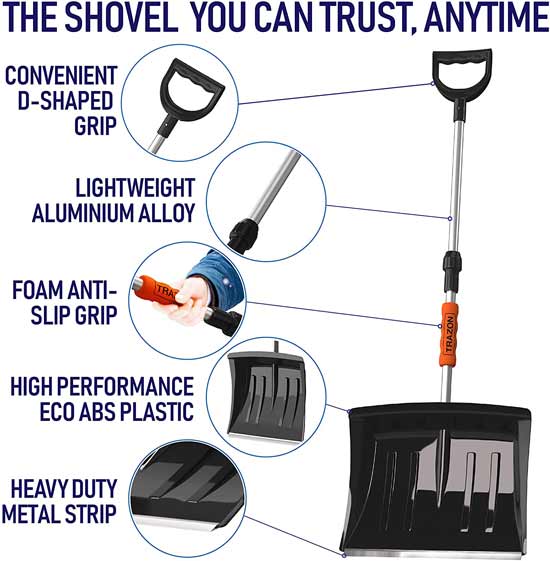
The procedure is as follows:
- Place a ladder at one end of the roof then anchor it in place.
- Climb with a shovel in one hand while being as careful as possible not to fall off the ladder.
- Once at the top, move at least 3 feet away from the edge then start shoveling above that rim of snow from the roof. At all times, maintain this rim and only remove it last. The purpose of the 3 feet of snow at the edge of the roof is to act as a security measure as it’ll stop your fall if you slip on the roof.
- Your shoveling should start from the area away from the end of the roof you propped your ladder. This allows you to simply disembark from the roof once done. Walking across the roof when done is risky as you won’t have that rim of ice to keep you on the roof in the case of a fall.
This method is great for the large amounts of snow that come after a heavy storm. Although it can be done at home, shoveling snow off the roof is best left for professionals as it’s full of risks and requires special gear such as non-slip shoes or even anchors on the body of the worker to be safe.
Avalanche Roof Rake Tool
This tool is some form of a rake originally created by Avalanche. This is the most efficient snow removal tool given that it works much like a rake but in specific sections and with a lot of safety.
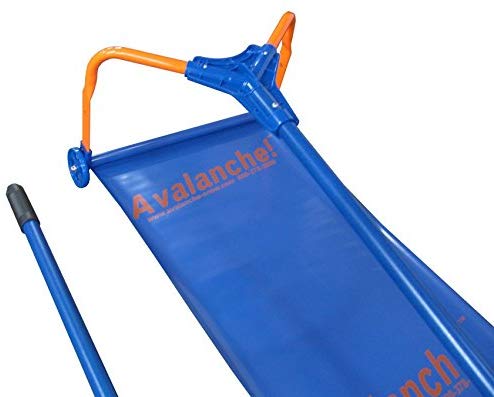
It has a pole made of fiberglass which makes it light but very strong. At the end of the pole are two pieces of metal that branch out and form vertical sections that are thin enough to slice through the snow.
These two pieces are joined and reinforced together by another piece of metal which doubles up as the anchor for a plastic slide.
This tool is used as follows:
- Hold the avalanche tool such that the plastic slide is facing downwards.
- Start at the end of the roof then insert the tool under the snow such that the plastic slide goes between the bottom of the snow and the roof as you push the tool upwards along the top of the roof. The two pieces of metal will cut throw the snow creating slices.
- After moving the tool a few feet into the snow, pull it out. It’ll come off with a chunk of snow which will slide off the roof on the plastic slide. Repeat until the whole roof is clear of the snow.
This roof rake is favored by many homeowners for its ease of use, safety and the fact that you can add wheels to the metal arms to prevent damage to the roof.
However, it may not be appropriate when;
- The ice/snow is wet and heavy
- The wind is extremely strong.
- Roof is flat(no slope)
Steamers
Last on our list is one of the very latest methods of removing snow and especially ice dams off roofs. Basically, it entails the use of hot steam at high pressure to melt and blow the snow and ice off your roof. It’s a very efficient and fast method as it doesn’t entail scouring the ice off the roof which may damage the latter.
The only thing to watch out for is that the water melting from the melting ice should be able to flow off the roof without damaging the parts under the shingles. Also, it may use some heated water which can be dangerous to solar roofs or solar panels.
DIY Roof Snow Removal Tool
Here is a video showing step by step guide to create your own snow removal tool at home.
When Should I Remove Snow from my Roof?
For most people, snow on the roof isn’t an issue as it’ll not build up enough to pose a risk on the roof. The cold season will come and go and the snow will melt away by itself.
In most cases, your roof will be safe from the snow given that most building codes require a certain strength of the roof in a specific area. This strength is based on the record for the heaviest snow in that area.
The thickness of the snow isn’t usually an issue; the type is what you should be concerned about.
This is because 38 inches of dry snow is equal in weight to 6 inches of wet snow. On average, a square foot of fresh snow weighs 3 pounds while wet snow weighs about 21 pounds per square foot. Ice weighs 57 pounds a square foot.
However, if you notice the following signs, you should highly consider removing the snow:
- Sticking interior doors and windows; if your interior doors on the second-floor start becoming difficult to open and close, it means that the weight of the snow is warping the roof downwards. They can doors to bedrooms, attics or even closets. The doors on the outside of the building aren’t a good gauge of this aspect are they’re often made of metal or have a thicker wall between them and the roof.
- Cracks around the doors and windows; in the doors mentioned above, you may notice cracks around the plaster or drywall close to their frames. In such a case, the need to remove the snow is urgent and should thus be handled fast.
- Creaking roof sounds; when you hear creaking roof sounds, it means that the roof is about to break due to the weight of the ice or snow.
- Bowing roof; similarly, a bowing roof is a dangerous sign pointing to a roof under the stress of too much snow or ice.
If you notice any one of these signs on your house, arrange for the snow to be removed as soon as possible. You should leave the house immediately in the case of the last 3 signs shown above.
Snow Removal from Roof Tips
To stay safe and avoid damaging the roof as you remove the snow from the roof, follow the tips below:
- Work with the weather patterns such that you only remove heavy snow if there’s no hope of rising temperatures. Otherwise, rising temperatures are quite efficient in eliminating snow from roofs.
- Always aim to clear the snow from the ground as it’s the safest method of doing so. Climbing the roof increases your chances of injury.
- Don’t allow more than a foot of snow to form on your roof.
- Aim to remove just part of the snow since scrapping all of it off the roof can damage the roof from the friction with the tool.
- Keep off electrical lines and other wires. These can lead to electrocution or blackouts which take longer to be fixed during the winter season. If there’s an electric cable close to the roof of your house, call in an expert to handle it.
- Stabilize or anchor the ladder on the ground and the roof to avoid falling off and causing injuries.
- Leave 3 feet of ice on the edge of the roof if you climb on it. This serves as your safety net in the case that you slip off the roof as it’ll stop your fall off the roof. Remove it last. Alternatively, you can some of the best roof safety harnesses or ropes/lifeline out there to hold in position while up there
- Don’t climb garages and other buildings with few walls as they easily collapse from the overhead weight.
- Be alert on where the snow falls to avoid injury.
- Steeper roofs have faster ice falls hence more dangerous.
- During periodic storms, remove the snow from the roof after each storm. This prevents its buildup during the next storm.
- Never use metal shovels or rakes as they’re likely to damage your roof. Use plastic instead.
- Always check for snowdrifts. These are areas of aerodynamic shade whereby snow builds up as the wind blows it into secluded areas from which it can’t be blown away by the same wind.
- Avoid removing snow towards the weaker side of the roof since it may easily collapse the roof.
- Don’t drop the snow over entries or exits of the house. In the case of an emergency, it’ll be tough using the exits.
- Start by removing rooftop snow drifts before the rest of the snow.
- Always aim to remove snow from the ridge of the roof downwards.
- As another safety measure, always have someone on the ground to warn passers-by of the falling snow when removing snow from the roof.
- Check where the snow falls when it comes off the roof. Avoid dropping it onto plants, gas meters and other items.
- Only remove the snow when necessary since the removal process wears down your roof however careful you may be.
- Even when not removing snow from the roof, avoid parking under the roof as chunks of snow often break off and drop off the roof. They’re usually heavy enough to total most cars.
Always keep these aspects and any other in mind to ensure that you’re safe and your roof isn’t damaged during the snow removal.
Ice/Snow on Roof Damages & Dangers
Snow should be removed from a roof only when it’s heavier than the roof can normally support. Most current roofs can support as much as 40 pounds (18.14kg) of snow or ice per square foot.
Older roofs may be compromised and will thus support less weight. As such, only attempt to remove snow on the roof when there’s a significant amount of snow or ice on it.
Ice damming
An ice dam is a ridge of ice which forms at the edge of the roof after a period of snow. Ice dams can also form on other parts of the roof especially where two or more parts meet one another. This ridge often prevents the ice that is melting from the upper parts of the roof from draining away.
These dams form when heat from the house melts the upper parts of the snow or ice. As it flows downwards, it meets colder snow which freezes it into ice. By the time it gets to the coldest part of the roof which is the ridge, it’ll be cooled into ice.
As more snow is melted into water, it flows towards the ridge of the roof. This water will flow underneath the snow and may get underneath the shingles of the roof thus damaging the house. You can see icicles hanging from the edge of the roof as part of the ice dam.
Besides being the heaviest part of the roof, the ice dam prevents the rest of the snow from melting off the roof naturally and will thus make it worse. It’ll also lead to water entering the area under the shingles and causing damage to the roof.
Too much weight on the roof
Snow has a significant weight if left to pile up for long. In most cases, light and dry snow will pile up to form heavy and wet snow which in turn may form ice. Each form of snow is heavier than the previous one.
As each roof has its weight capacity, too much of it will damage the roof and, in the worst cases, may see your roof break inwards under the weight of the snow.
Rotting of roof parts
When ice dams form on the roof, they’re likely to allow the water melting from the top of the roof to enter the area under the shingles. Besides that, melting snow can easily damage the roof making it weaker and less likely to support heavier piles of snow.
Blocking and Damaging of Vents
Chimneys, plumbing and air vents can eb easily damaged and even blocked when snow piles up on your roof. Without removing it periodically, the damage may be enough to warrant a change of the vent or other implement.
Snow Ingestion
Snow can enter ventilation openings as wind blows it inside. Without action, this snow will form ice which further makes it hard to remove it. Eventually, the snow and ice can block the ventilation.
This requires that the intakes at eaves be baffled to block the ingestion of snow.
These are just but a few of the reasons you need to remove snow from your roof whenever it gets to a certain thickness.
How to Prevent Roof Snow
While it’s basically impossible to prevent snow from falling unto your roof, there are methods you can employ to reduce the amount formed and the time taken to remove the snow off the roof. These include the following:
Avoid Low-Pitch Roofs
With a low angle of inclination, snow doesn’t fall off and instead piles up creates regions of pressure which may eventually lead to damage. To be on the safe side, remove the snow at about 18-20 inches of thickness for the fluffy one. For the heavy and wet type, 6 inches is enough for a removal.
Build House in East-West Orientation
While you can have your house facing any direction of your choice, try have the roof oriented in an east-west direction. This orientation helps with the faster melting of ice given the movement of the sun. Essentially, the sloping areas should be facing east or west to receive most of the sun’s warmth in the day.
Using Heat Cables
Heat cables are wires that are laid on the roof which are connected to the power circuit and heated during the winter months. As the snow falls on them, they quickly melt it preventing its accumulation on your roof.
The use of cables isn’t foolproof since heavy snow can easily overwhelm the snow and form in between the cables where the cables can’t heat. Also, heat cables are quite expensive to install and maintain as they use lots of electricity. Given the way they’re set up, they also have a significant failure rate. They, however, work in most cases.
Flatter Roofing Designs
Avoid roofing designs with valley as they’re hard to reach when removing the snow off them. Steeper roofs also accumulate less snow as most of it will just fall off it.
The degree of inclination (pitch) of the roof also determines how much weight the roof can withstand. Flatter and steeper roofs spread out the weight of the snow and can thus withstand more weight per square foot.
Remove Snow Frequently on Low-Pitched Roofs
This avoids the snow accumulating on the roof to cause issues such as too much weight or ice dams.
Use Metal Roofs
Metal roofs shed the snow and ice better. This is because metal conducts heat faster and will thus melt the snow faster than other materials would. It’s also easier to remove snow off metal roofs as it easily falls off when raked.
These methods will make it easier to live in a snowy area as they make it easy to shed snow off your roof whenever it piles up.
Sources
- Minimizing the Adverse Effects of Snow and Ice on Roofs
- Roof-Snow Behavior and Ice-Dam Prevention in Residential Housing
- LaChapelle, E. (1966). The Control of Snow Avalanches. Scientific American, 214(2), 92-101. Retrieved from http://www.jstor.org/stable/24931271
As an Amazon Associate, we earn from qualifying purchases. Details here
